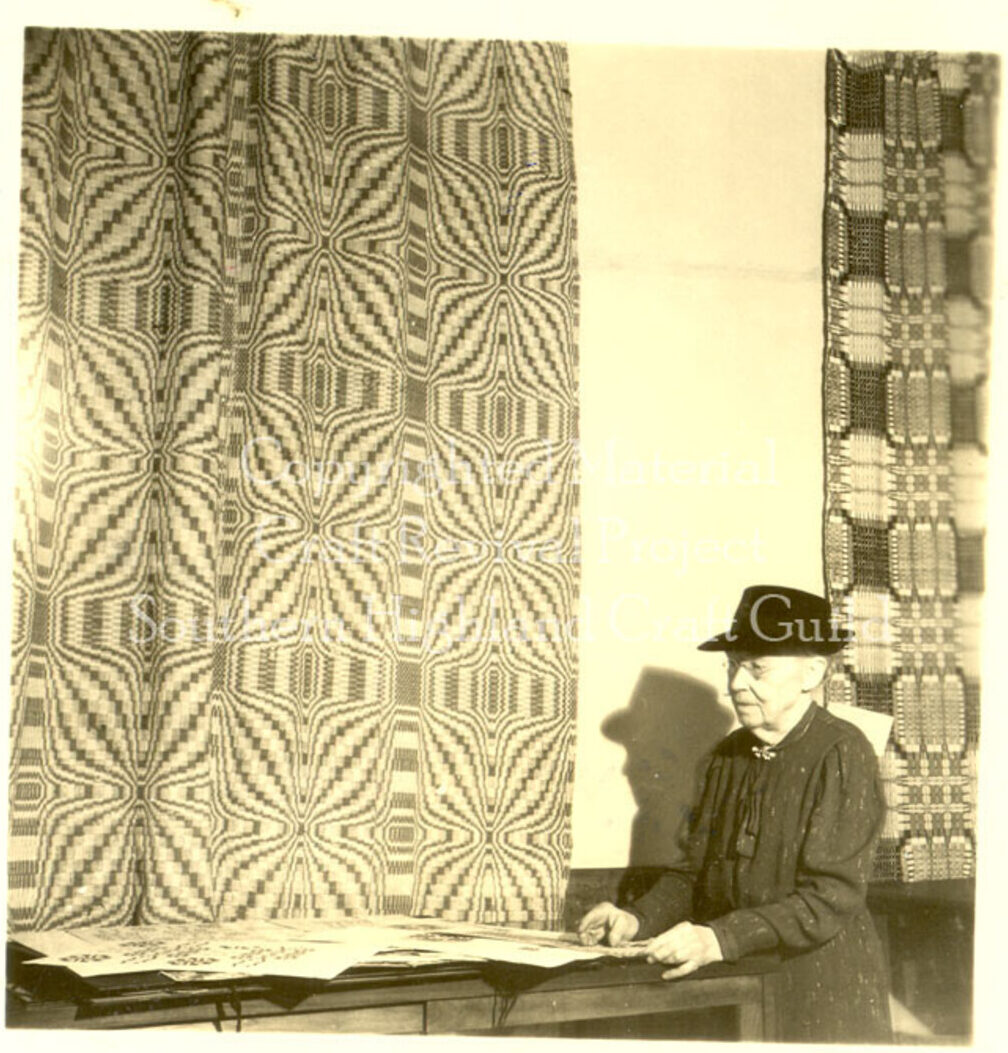Francis Goodrich’s Handicraft Revival
135 Years Ago
In early 1890s Brittain Cove, NC, Rebecca Taylor Davis handed an old coverlet to New York-born Presbyterian missionary Francis Louisa Goodrich. “I’ve brought you a present, knowing that you take delight in such as this,” Davis told her new friend.
Unbeknownst to Davis at the time, this coverlet–woven in the “Double Bowknot” pattern with wool that had been dyed brown with chestnut and oak bark–would spark the craft revival movement in western North Carolina and eventually lead to the formation of what is known today as the Southern Highland Handicraft Guild.
Beginnings
American missionaries from varying denominations, like Francis Goodrich, began making their way into Appalachia shortly after the Civil War, labeling white mountaineers as an “exceptional population” in need of aid, alongside Native Americans, newly-free African Americans, Mormons, and other marginalized American groups.
Goodrich arrived at Riceville’s College Hill School, located a few miles east of Asheville, to assist another mission teacher, Evangeline Gorbold, in the fall of 1890. Gorbold taught; Goodrich, an unpaid volunteer, took up most other duties–visiting homebound residents, bringing food or medicine to the sick, helping with funeral arrangements, and generally doing any tasks that would endear her to the community.
After serving two years at the Riceville school, Goodrich and Gorbold moved just over the mountain to Brittain Cove. Here they helped establish another day school. More than 80 children attended the first year–more than double their expectations.
Inspiration
Outside the classroom, Goodrich worked particularly to uplift women in the community, starting “mothers’ meetings,” which provided a social space for women to share news, offer advice, and support each other. Goodrich aspired to “bring material help to the poorer among these neighbors without hampering them, or injuring their self-respect.”
So when during one of these meetings Davis gifted her the “home-woven coverlet, forty years old, slightly faded, but still beautiful in its golden brown and cream white hues,” Goodrich was inspired. In this “Old Brown Coverlet,” she saw a method of bringing supplemental income into the hands of mountain women.
According to Jan Davidson’s introduction in a reprinting of Goodrich’s 1931 book, Mountain Homespun, by the 1890s, Colonial Revival style had emerged and hand woven coverlets had become sought after commodities.
But these coveted blankets could generally only be found in museum displays. So when Goodrich sent the coverlet to her northern friends, “the admiration it received made [her] believe that if [the women] in the cove could produce the like, a market could be found.”
Reestablishing a more or less forgotten skill in the mountains required locating women who still had the knowledge–and equipment–to weave a coverlet from beginning to end. Soon Goodrich and members of the mothers’ meetings had found an old loom stored in a local barn, a woman who could weave, another who could warp a loom, still another who could dye with indigo, and a nearby family who could produce the coverlets. In three weeks, they produced three coverlets. All three immediately sold; a handicraft revival had begun in the mountains.
Allanstand Cottage Industries
Though successful programs combining handicraft with social work had already seen success in other areas of the US and Europe, Goodrich’s program was a first for Southern Appalachia.
By 1902, Goodrich had set up Allanstand Cottage Industries in Allanstand, NC, near the North Carolina-Tennessee border. She paid women to weave in their homes and then purchased each work piece by piece to sell. As the industry grew, she began commissioning a wider variety of handwork, including rugs, brooms, baskets, chairs, and dolls. In 1908, she opened a shop in downtown Asheville to sell mountain handicrafts to tourists. Many crafts were also sold by mail order through the Presbyterian Church.
In 1931, Goodrich gave Allanstand to the fledgling Southern Mountain Handicraft Guild (now the Southern Highland Craft Guild). The Allanstand Shop currently operates out of the Folk Art Center on the Blue Ridge Parkway in Asheville, just a few miles from the former location of the small Riceville schoolhouse where Goodrich got her start as a missionary in the mountains.
For more, check out Mountain Homespun by Frances Goodrich (1931). The 1989 edition includes an introduction by Jan Davidson which was particularly helpful in writing this article.

